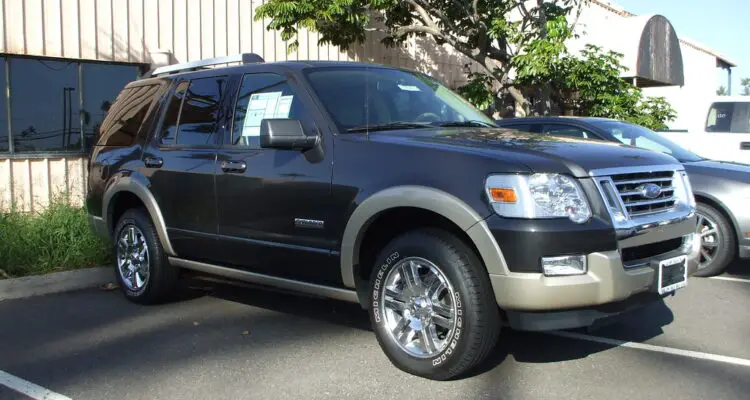For car novices and aficionados alike, grappling with car problems is an inevitable part of the journey. When it comes to the Ford Explorer, a flagship SUV renowned for its versatility and performance, having insights into diagnosing and resolving issues is indispensable. In this guide, we’ll delve into the prevalent problems across different Explorer generations and offer valuable advice for tackling them effectively.
1ST GEN EXPLORER: Embarking on a New Era
The inaugural Ford Explorer generation, spanning from 1991 to 2001, held grand ambitions of blending road prowess with off-road prowess. Unfortunately, this ambition was often undermined by troubles, particularly in its association with Firestone tires. These tires proved ill-matched for the Explorer’s dynamics, causing accidents and sparking a series of fatalities. Notwithstanding these setbacks, the first-gen Explorer set the stage for family-oriented SUVs, emphasizing cargo space and off-road capabilities.
2ND GEN EXPLORER: Navigating Persistent Challenges
The second-generation Explorer, unveiled in the late 1990s, introduced a rounder silhouette and the option for a small-block Ford V8 engine. Regrettably, it also inherited issues from its predecessor. Predicaments encompassed broken tensioners, transmission malfunctions, and brittle plastic timing chain guides. These glitches culminated in the notorious “death rattle,” a precarious state that could result in engine seizure if not promptly addressed.
3RD GEN EXPLORER: An Evolution with Mixed Results
The third-generation Explorer marked a dramatic overhaul, aiming to surmount past shortcomings. This version debuted independent rear suspension and the choice of all-wheel drive, amplifying power and comfort. However, the 2002 iteration confronted numerous grievances concerning transmission glitches, paint cracks, and drivetrain troubles. Transmission woes ranged from slipping to the blinking of Overdrive (O/D) lights.
Common Issues and Resolutions:
- Transmission Failures: A recurring headache spanning generations, transmission hiccups demanded costly repairs, averaging between $1800 and $3400. Swift intervention was imperative to thwart further deterioration.
- Blinking O/D Lights: Although not the most severe setback, flickering O/D lights served as a red flag for transmission problems. Rectifying this conundrum incurred expenses of around $2500, often manifesting around the 109,100-mile mark.
- Transmission Slippage: Audible shifts or clunks signaled transmission slippage, frequently attributed to inadequate transmission fluid or insufficient maintenance. Ford’s remedies comprised recalls and transmission replacements, tallying an average cost of $2200.
- Transmission Overhauls: Overhauling or rebuilding the transmission emerged as a viable solution, with the average repair charge approximating $2500, usually surfacing just shy of 90,000 miles.
4TH GEN EXPLORER: A Renaissance of Enhancements
The fourth-generation Explorers introduced substantial upgrades, including power-folding 3rd-row seats, overhauled rear suspension, and electronic stability control. Ford endeavored to combat transmission predicaments with an improved version, constituting a commendable advancement over preceding iterations.
5TH GEN EXPLORER: A Defining Epoch
The fifth-generation Explorers marked a pivotal departure, adopting unibody construction and proffering advanced technological accouterments like adaptive cruise control and revamped Ford SYNC. A novel engine lineup, encompassing the efficient 2.0-liter turbocharged EcoBoost, addressed concerns of fuel efficiency. The design transformation negated rollover perils, heightening safety measures.
6TH GEN EXPLORER: Forging Ahead
The sixth-generation Explorers, unveiled in the late 2010s, perpetuated the triumph of their antecedents. A comprehensive redesign, fortified engines, and cutting-edge features sustained the Explorer’s competitiveness. The 2020 rendition introduced the Explorer ST and Explorer Hybrid variants, spotlighting Ford’s dedication to innovation and fuel conservation.
Conclusion: Guiding Through Ford Explorer Woes
Across its multifarious generations, the Ford Explorer has grappled with a multitude of tribulations, spanning transmission fiascos to tire-related mishaps. However, Ford has remained steadfast in rectifying these quandaries and furnishing improved remedies. Whether you’re at the helm of an older model or a more contemporary one, staying apprised of prevalent complications and their remedies is instrumental in upholding your Explorer’s performance and ensuring a secure driving experience.
So, when grappling with “Ford Explorer problems,” take heart – armed with the right knowledge, you’re empowered to diagnose, troubleshoot, and mend myriad maladies on your own or with professional aid. Remember, comprehending your vehicle is the first stride toward a lasting automotive voyage.







